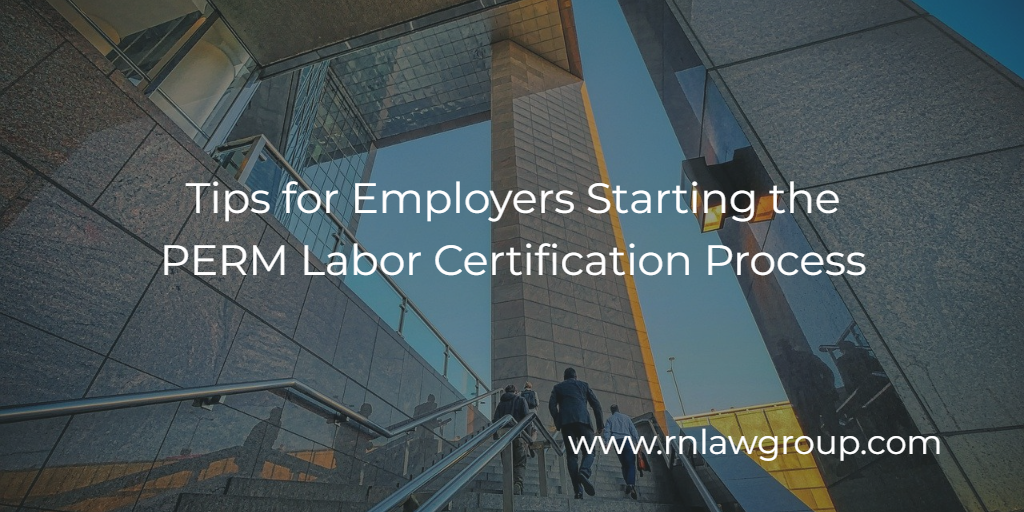
Tips for Employers Starting the PERM Labor Certification Process
There are usually 3 steps to the employment-based green card process: (1) PERM Labor Certification, (2) I-140 Immigrant Petition, and (3) Adjustment of Status. An employer filing a PERM Labor Certification must demonstrate to the Department of Labor (DOL) that U.S. workers will not be displaced by hiring a foreign worker to fill a permanent position with the company. Therefore, employers must conduct a series of recruitment activities to adequately test the U.S. labor market for able, willing, qualified, and available U.S. workers. If no such workers are found, the employer may file a PERM Labor Certification on behalf of the foreign worker.
The PERM labor certification process is usually the biggest hurdle to clear because the process is lengthy, involves multiple stages, and requires careful strategizing to avoid missteps along the way. In order to help avoid major issues during this process, I have provided the following tips for employers starting the PERM Labor Certification Process:
- Properly draft the job description for the sponsored position: Developing the PERM job description forms the core of the PERM application. When a foreign worker is sponsored for a PERM-based green card, the employer must ensure that the job details set forth in the PERM Labor Certification will still be valid once the green card is issued. A material change in the position details may require the employer to file a new PERM application in the future. This can be an issue for those employees born in countries with a significant green card backlog, such as India and China. Therefore, it is imperative to carefully consider what the future position will entail. In certain situations, the job description may need to be more generic. Describing the position in broad terms might be best so that modest changes in the job duties over a period of years do not change the job description. Please note though that a change in job location that is outside the area of intended employment specified in the PERM application will require an employer to file a new PERM application.
- Ensure the job reflects the company’s “minimum” requirements: The DOL limits the requirements for the sponsored position to the employer’s actual minimum requirements for the job. These requirements can include the employer’s education, experience, and skill requirements and also any license or certification requirements. The requirements should not be based on preference. Further, the requirements for the position should not be unduly restrictive or tailored to the beneficiary because this can be seen as disadvantaging U.S. workers by unfairly restricting the applicant pool. For example, an employer prefers a prospective employee to have a Master’s degree in Computer Science for a Software Engineer opening, but confirms that at a minimum an individual with a Bachelor’s degree in the same field would be able to perform the role. Additionally, the employer has hired other employees for the same exact position who all had Bachelor’s degrees only. In this instance, the employer’s minimum education requirement must be reflected as a Bachelor’s degree in Computer Science.
- Ensure the company pays for all aspects of the PERM process: Per DOL regulations, the employer must pay all of the costs associated with the PERM process. This includes attorney’s fees and costs of advertising for the position. Further, reimbursement of fees by the employee to the employer is not allowed. Employers must be aware of this rule. If the DOL discovers that the employee paid for portions of this process, the company will be investigated and could incur hefty penalties.
- Frequent PERM filers should have consistent job descriptions and minimum requirements: Employers who file a high volume of PERM applications should have consistent minimum requirements across applications within the same occupation. A lack of consistency could lead the DOL to conclude that the requirements do not reflect the actual minimum requirements for the role. Employers should be prepared to support any discrepancy, where applicable. For example, the employer may have a particular project that justifies the deviation from the standard job description and minimum requirements for a particular role.
- Ensure the foreign worker fully qualifies for the sponsored position: The employee must meet the minimum requirements listed on the PERM application as of the date the PERM application is filed. The employee should provide all qualifying education and experience documentation at the start of the PERM process to confirm that the minimum requirements for the job opportunity are met. For example, if the position requires a Masters in Computer Science and 3 years of experience, the beneficiary should provide copies of all qualifying educational diplomas and transcripts along with detailed employment verification letters. For more details, please see my previous article Planning Ahead to Ensure I-140 Approval.
- Avoid audit triggers: The DOL implements a quality control process in the form of PERM audits to ensure compliance with all regulations. Although the DOL issues audits at random as part of its quality control process, there are certain audit triggers that can be recognized from the outset of this process. Understanding these triggers may provide you with an edge going into the process. For a list of audit triggers, please see my previous article: Minimize Your Risk of PERM Audit by Recognizing These Audit Triggers.
- Determine if the company has ability to pay the prevailing wage: At the I-140 stage of the employment-based green card process, the U.S Citizenship and Immigration Services (USCIS) will verify that the company has the ability to pay the foreign worker the wage listed on the PERM application (the prevailing wage or offered wage, whichever is higher). The employer will have to demonstrate ability to pay from the day the PERM application is filed to the day the employee obtains the green card. There are 3 ways to demonstrate ability to pay:
- Evidence that the wage paid to the foreign worker is equal to or greater than the proffered wage (pay-stubs, W-2s);
- Evidence that the company’s net income is equal to or greater than the proffered wage (annual report, tax return, or audited financial statement); OR
- Evidence that the company’s net assets are equal to or greater than the proffered wage (annual report, tax return, or audited financial statement).
If the employer cannot demonstrate its ability to pay, the I-140 petition will be denied. Therefore, it is important to make this determination from the start of the PERM process.
8. Understand the importance of dates: DOL regulations require that certain advertisements run for a set period of time during the recruitment phase of the PERM process. DOL regulations also have a mandatory “quiet period” during which the PERM application cannot be filed. In addition, the prevailing wage determination has a validity period that must be considered in connection to recruitment. One small mistake involving dates could end with a denial of your PERM application. Understand and remain knowledgeable of these rules to avoid improper filing.
9.Comply with the recruitment process: Applications received from U.S. workers during the recruitment phase must be reviewed by the employer carefully. An employer may only disqualify a U.S. applicant for lawful job-related reasons in accordance with DOL regulations. Further, all documentation must be maintained, including copies of posted advertisements and all resumes received. This information will be used to create a recruitment report that must be signed by the employer describing the recruitment steps undertaken and the results achieved, the number of hires, and, if applicable, the number of U.S. workers rejected, categorized by the lawful job-related reasons for such rejections. The employer will have to stop the foreign worker’s green card process if a qualified and available U.S. worker for the job opportunity is found during the course of the recruitment process.
10. Respond to the sponsorship verification email: Once a PERM application is electronically filed, the employer will receive 2 emails. The first email is a confirmation that the application was received by the DOL. The second email is called a sponsorship verification email. This email contains a questionnaire that basically asks the employer to verify sponsorship of the foreign worker. The DOL allows the employer 30 days to respond to this email (it is also important that the employer keep their contact email and phone number up to date on the application). If the employer does not respond within 30 days, processing of the PERM can be delayed or rejected.
If your company is initiating the PERM-based green card process for a foreign worker, it is important to speak with a qualified immigration attorney to provide guidance through this process.
By: Krystal Alanis
Krystal Alanis is a Partner at Reddy Neumann Brown PC, Houston’s largest immigration law firm focused solely on U.S. employment-based immigration. She acts as the Managing Attorney for the firm’s PERM Labor Certification Department, where she oversees all EB-2 and EB-3 employment-based green card matters. She also guides employers and individuals through the I-140 and Adjustment of Status process, assists clients with non-immigrant visa petitions (e.g. H-1B, TN, L-1, etc.), and advises her clients on I-9 compliance issues.

